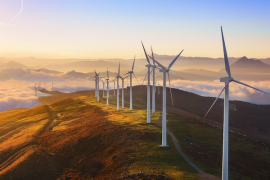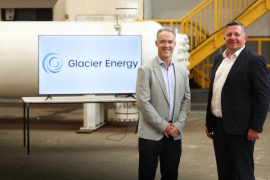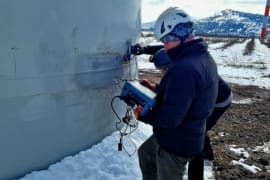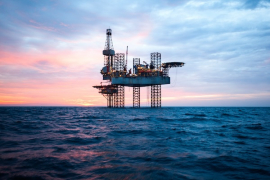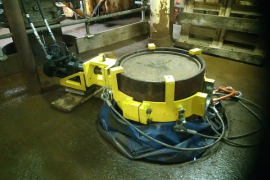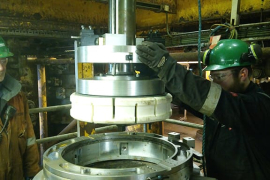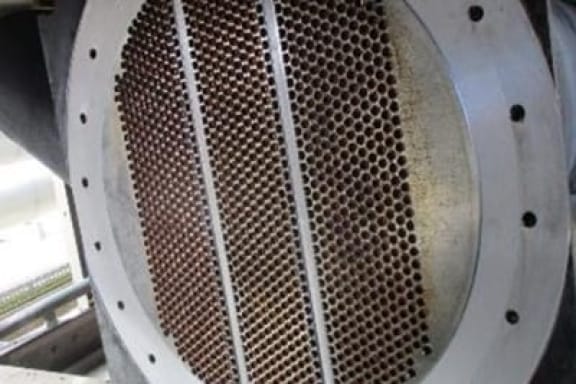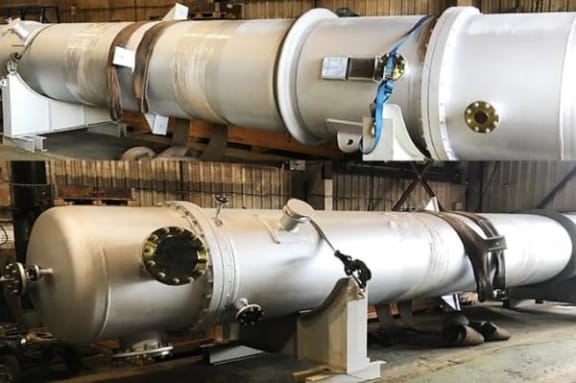Caron Rose
Glacier Energy has invested in Ilosta, a leading provider of digital AI monitoring software, Crack Map™. The investment marks the beginning of a commercial agreement between Glacier Energy and Ilosta, enabling best-in-class data collection, analysis and reporting incorporating advanced 3D modelling.
Ilosta, headquartered in Glasgow, has developed Crack Map™, a market-leading technology that uses a physics-based AI algorithm to improve the reliability and increase the lifespan of structures such as wind turbines. Glacier Energy has been working with Ilosta for a number of years and is now offering Crack Map™ as part of its wind services offering.
Glacier Energy’s investment in Ilosta forms part of a funding round alongside existing investors, supporting the commercialisation of the software, the go-to-market strategy, and the development of the software for additional applications. The development of the Crack Map™ technology will assist in meeting the market’s increasing demand for condition-based monitoring, especially as the wind market matures and assets begin to age.
Paul Johnston, Inspection Services Business Unit Director said “I am delighted that Glacier Energy has invested in Ilosta, enhancing our ability to provide innovative solutions for our clients. Entering into commercial agreements with technology companies like Ilosta is a key differentiator as we look to drive business growth."
Saber Khayatzadeh, Founder at Ilosta added: “We are excited to enter a commercial agreement with Glacier Energy, a leader in energy services. This collaboration marks a significant step toward revolutionising asset management in renewable energy and beyond. By integrating our Crack Map™ technology, we aim to enhance the performance and lifespan of wind turbines and other critical engineering structures, delivering advanced insights that boost efficiency and maximise returns for end users. Together, we are driving innovation and sustainability forward."
Stockton-on-Tees acquisition increases Glacier Energy headcount to over 300.
Glacier Energy, a specialist provider of products, services, and engineered solutions for renewable and conventional energy markets, today announces the acquisition of Francis Brown, a long established, well-respected Teesside fabrication business.
Established in 1903, Francis Brown is a leader in the manufacture of pressure vessels and structural fabrications. The move strengthens and broadens Glacier Energy’s UK manufacturing capability, which is evolving to support its soon-to-be launched range of hydrogen storage and distribution products.
The transaction was arranged by FRP Advisory following its appointment as administrators of Francis Brown, with the sale to Glacier Energy coming as part of a pre-pack administration.
The successful acquisition will take the Glacier Energy Group head count to over 300, with all employees transferring from Francis Brown, contributing to the strategic growth plan to double the size of the group by 2028.
Drawing on strong customer demand, the company will now create a larger manufacturing division within two key locations at Stockton-on-Tees-and Rotherham to support strategic sustainable energy projects and growing manufacturing requirements.
The Directors of Francis Brown, Jamie Brown and Duncan Warriner will remain with the business and will hold senior roles within Glacier Energy’s manufacturing division.
Scott Martin, CEO of Glacier Energy, said: “Francis Brown is a well-respected family business that aligns perfectly with our plans to increase our capacity and capabilities in Teesside as a strategic location. We look forward to integrating their excellent team to realise significant opportunities ahead and building the strong relationships we have already established.
“Recent strategic investment from Averroes and BGF was secured to support Glacier Energy’s rapid growth, both organically and through strategic acquisitions. This news underlines positive progress, and we look forward to continuing this journey at pace.”
Jamie Brown, Francis Brown, said: “Extensive discussions with Glacier Energy in advance of the acquisition underlined how aligned we were, both in terms of the potential opportunity ahead, but also in terms of our respective cultures. I’m looking forward to this exciting next step.”
A Leading UK Manufacturer of Innovative Hydrogen Products
Drawing on 85+ years of design and manufacturing experience, Glacier Energy is a leading UK provider of innovative hydrogen storage products and bespoke hydrogen heat exchangers and pressure vessels.
Today, Glacier Energy is one of the only dedicated design and manufacturing companies in the UK with specialist hydrogen, thermal and mechanical engineering capabilities and a proven track record in the renewables industry.
Photo (L-R): Nick Horler, Non-Executive Chairman; Scott Martin, Group CEO and Mark Ritchie, Group CFO.
BGF, one of the largest and most experienced growth capital investors in the UK and Ireland, announces a multi-million pound investment in Glacier Energy, joining Averroes Capital as investors in the business.
BGF took a minority stake in the Aberdeen-headquartered energy services company after following its growth and expansion into the broader renewables market for a number of years.
With the support of Averroes and BGF, Glacier Energy will now continue the rapid growth delivered in the last two years, and is investing in additional manufacturing capacity and establishing a technician training academy. It will also pursue further strategic acquisitions.
Glacier Energy is a specialist provider of products, services, and engineered solutions for a wide range of industrial and energy markets. Its core capabilities include heat transfer and pressure vessels, machining, welding, and Non-Destructive Testing (NDT) and inspection services. These specialisms are well suited to the energy transition, and Glacier Energy has been instrumental in advancing in-demand hydrogen, carbon capture, and energy storage technologies.
Founded in 2011, the business has completed 11 acquisitions and has been an early-mover in leveraging its engineering and technical expertise to support low-carbon technologies. It directly employs 220 people plus 20 contractors, and is now recruiting further capacity.
Building on strong growth, and to realise further ambitions underpinned by new investment, the company recently welcomed Nick Horler as Non-Executive Chairman and Mark Ritchie as Group CFO.
Nick joined following a longstanding executive career across the energy, oil and related infrastructure industries in the UK and USA. Alongside his new role with Glacier Energy, he also Non-Executive Chairman of Horizon Energy Infrastructure and Smart Meter Assets. Nick was CEO of Scottish Power until 2010, following which he has held several non-executive roles with the Royal Mail, Go-Ahead Group, Thames Water, UK Power Reserve and more recently ESP Utilities group.
Mark is a member of the Chartered Institute of Management Accountants. Mark has over 20 years’ financial experience, ten years of which have been spent in Board level roles in private equity backed businesses. Prior to joining Glacier Energy, Mark was CFO of RCapital portfolio company Richard Irvin FM, and a key member of the management team that led the sale of the business to the RSK Group. He has worked in the Energy sector for a significant part of his career, with CFO roles at ICR Integrity (Graphite Capital) and AIM listed energy engineering company Enteq Technologies.
Richard Pugh, an Investor at BGF, said: “We have known Scott Martin for over ten years and have been impressed at how he and the team have grown Glacier Energy while also achieving success in a diverse set of high-growth markets. We are really excited about the scale of ambition, involving investment across multiple sites in Scotland, as well as in Yorkshire and the North East of England. It is also great to invest in a business that is already working with other portfolio companies.”
Scott Martin, CEO of Glacier Energy, said: “We are thrilled to welcome BGF as a key partner in our growth journey alongside Averroes Capital. With BGF’s support and experience, we are well-positioned to accelerate our growth and further contribute to the development of sustainable energy solutions.
“The addition of Nick Horler and Mark Ritchie to the company’s leadership team underlines our ambition. We have secured two of the best in the industry who will drive Glacier Energy to the next level.”
Simon Rowan, Partner, Averroes Capital, said: “We are delighted to bring BGF on board as a co investor and believe this will significantly enhance the undoubted growth prospects of Glacier Energy. The business has made large strides forward following our recent investment, and we look forward to seeing this positive momentum continuing alongside BGF”.
Kenny Erskine, Operations Director at Glacier Energy has over 20 years’ experience working within the energy industry, specialising in the repair and refurbishment of heat exchangers. Throughout his career, Kenny has seen first-hand the issues that clients face with their heat exchangers that are inefficient but still in operation.
In this blog, Kenny shares his thoughts on the impact that inefficient heat exchangers can have on your process and his perspective on how to fully maximise efficiency for optimal results.
Why might a heat exchanger be operating ineffectively?
There could be a variety of reasons that you are experiencing problems with your heat exchangers. Perhaps your unit has not been originally built to successfully withstand it’s current operating environment, it has corrosion, fouling/blocked tubes or has been exposed to corrosive or harsh conditions.
Tubes can also fail due to issues such as erosion/corrosion, tube fretting, mechanical damage or thermal stress.
Heat exchangers tend to have a design life of around 20 – 25 years when maintained. If the unit is coming to the end of its operational life span, this could be a reason why it is not performing how it should.
An issue that we regularly come across with our clients equipment is fouling which can be described as a build-up of deposits such as sea growth or scale. Excessive fouling can drastically reduce operational performance/efficiency and increase energy consumption. To prevent this, we advise carrying out regular maintenance inspections.
In short, there are multiple reasons why you could be experiencing issues and it is critical that subject matter experts help identify the root-cause of any problems and propose corrective actions.
What issues can an inefficient heat exchanger cause?
Unplanned Downtime
Heat exchangers that are operating inefficiently may need to be taken offline for cleaning, repairs or maintenance, causing unplanned downtime.
In order for our clients to improve their operations and stay ahead of the competition, we suggest adopting a proactive maintenance strategy which includes regular ‘health checks’ of equipment to flag up potential issues.
Lost Production
Lost production in the UKCS due to heat transfer equipment failures is estimated to be around £600million. You can therefore understand why regular maintenance and refurbishments are critical for mitigating potential losses and improving operating efficiencies.
Environmental Impact
Inefficient heat exchangers can cause increased energy consumption due to the unit requiring more energy to serve its overall purpose. As energy companies are under increased pressure to optimise the performance of their equipment and lower their carbon footprint, it is critical that any unnecessary environmental impact is prevented from an inefficient heat exchanger.
That is one reason why we developed our heat exchanger predictive maintenance tool, HTX Digital which supports the drive towards net zero and can reduce maintenance costs and unplanned downtime by up to 30%.
Safety risk
If working ineffectively, this can cause pressure build up, overheating, corrosion / leaks or environmental hazards through pollution. Ensuring that your heat exchanger is operating effectively by addressing inefficiencies through proper design, maintenance, and monitoring is essential to mitigate these safety risks.
To fully optimise efficiency of your heat exchanger, when would you recommend scheduling a service?
It is advised that you should schedule regular maintenance inspections of your heat exchangers to flag up any potential problems and resolve them before they cause you more issues further down the line.
Our clients maintenance schedules vary. Some opt to carry out reactive maintenance/fix on fail which we don't advise, others do yearly checks for units which are a risk to production or downtime if they fail and some go for maintenance checks every 2/3 years.
Some of our clients get in touch when they themselves have identified a problem. This is often due to temperature pressure monitoring, failing tubes or noticing a decrease in overall performance.
In short, there is no hard and fast rule. It ultimately comes down to preference, budget and the units working environment/conditions.
How can Glacier Energy help clients maximise efficiency?
The first step would be to get in touch with our team. Our heat exchanger experts will discuss your current unit and potential problems that you are facing, create an action plan and recommend the most suitable inspection scope.
As our expertise extends to servicing heat exchangers both onshore and offshore, depending on your situation, we would bring your unit in to one of our workshops or send our team directly out to your site.
An initial inspection would then be carried out including a pressure test and full strip down of the unit. After that’s complete, a visual inspection would be undertaken to fully understand the condition of your heat exchanger.
We would then report back to you with our findings and advise on next steps to help you fully optimise your heat exchanger’s efficiency.
At Glacier Energy, we offer the complete mechanical solution including onshore/offshore inspections and repairs, workshop refurbishment and overhauls’, all supported by our inhouse design and manufacturing capabilities.
Get in Touch
If you would like to maximise the efficiency of your heat exchangers and need some assistance deciding the best option for you, contact us through the form below and we’ll get back to you.
With thousands of platforms and structures scheduled for removal globally, along with many approaching end of production, there’s a demand for decommissioning and deconstruction specialist service companies operating in the energy sector.
However, decommissioning projects are time consuming and complex undertakings that require input from a variety of specialist contractors.
Oil and Gas decommissioning companies are often well-equipped to handle the complexity of the work involved in plug and abandonment (P&A) or decommissioning of a platform with the assistance required by onsite machining experts to support projects or ringfenced scopes.
That’s where Glacier Energy’s ability is best placed.
We are well-versed at operating in demanding environments and familiar with the Well construction and infrastructure of majority of the offshore production platforms.
Drawing on over 70 years of institutional experience, we provide the engineering solutions, equipment and specialist technicians needed to carry out deconstruction machining projects to assist with full decommissioning package.
We have a proven ability to deploy globally within 24-48 hours and work side-by-side with our clients to ensure we provide the capable of overcoming the complex engineering challenges of our clients, before costly delays to decommissioning projects.
Glacier Energy, a specialist provider of products, services and engineered solutions for renewable and conventional energy markets is pleased to announce that it has been acquired by Averroes Capital.
As part of the acquisition, Averroes Capital has provided Glacier Energy with growth capital to invest in strategic growth initiatives and facilitated the exit of Glacier Energy’s existing institutional investors in Maven Capital and Simmons Parallel Energy Fund, who have supported the business since its inception in 2011.
Glacier Energy has been leveraging its engineering and technical capabilities to support low carbon technologies including hydrogen, carbon capture and energy storage with their core capabilities focused on heat transfer and pressure vessels, machining, welding and NDT and Inspection. As it embarks on further growth, Glacier Energy is focused on taking advantage of positive market drivers in the energy landscape, in particular the energy transition, energy security initiatives and decommissioning. These trends are driving investments into both low carbon technologies and existing energy sources.
Scott Martin, Group CEO of Glacier Energy, said: “I am delighted that we secured this investment from Averroes Capital and look forward to working with them to capitalise on the significant momentum we have in the business. Glacier Energy is very well placed to play a large role in the energy transition and having access to further investment for the next phase of our journey will accelerate this. I would also like to take the opportunity to thank the investors who have now exited the business as part of this transaction and am extremely grateful for the support they provided to me and the team.”
Jack Scott, Investment Director at Averroes Capital, said: “We are excited by the opportunity to partner with Scott Martin and his team to support the business on its next stage of growth. Glacier Energy is seen as a trusted partner to its clients and is well positioned to capitalise on the strong demand for integrated technical expertise in its niches, particularly within renewable and other low carbon energy sectors.”
Simon Rowan, Partner at Averroes Capital, said: “Glacier Energy presents an exciting opportunity for our investors to support a well-established and growing platform with a leading reputation in its markets. The entire Averroes team has been impressed by the experience and ambition of Scott and the broader Glacier Energy team and we look forward to supporting them. We are focused on unlocking attractive investment opportunities through our model of alignment and partnership, backing exceptional management teams, and assisting them on their growth strategy.”
Simon Rowan and Jack Scott will join the Glacier Energy Board from Averroes Capital, with further appointments to strengthen the Board being planned.
The condition of wind turbine blades directly impacts the efficiency and longevity of the wind turbine.
Over time, blades are exposed to harsh environmental conditions, including extreme temperatures and heavy winds. This consequently leads to issues such as lightening damage, erosion or cracking, which if left unchecked may result in costly performance declines and the need for major repairs.
With over 30 years’ experience in the wind industry, we’ve built up a strong reputation as a progressive partner, highly focused on new innovations and techniques to provide our clients with well-informed integrity recommendations. Using our extensive wind expertise, we help our clients save time and money by offering market-leading blade inspection, maintenance and repair services to detect any integrity problems early on and ensure that they are dealt with accordingly.
